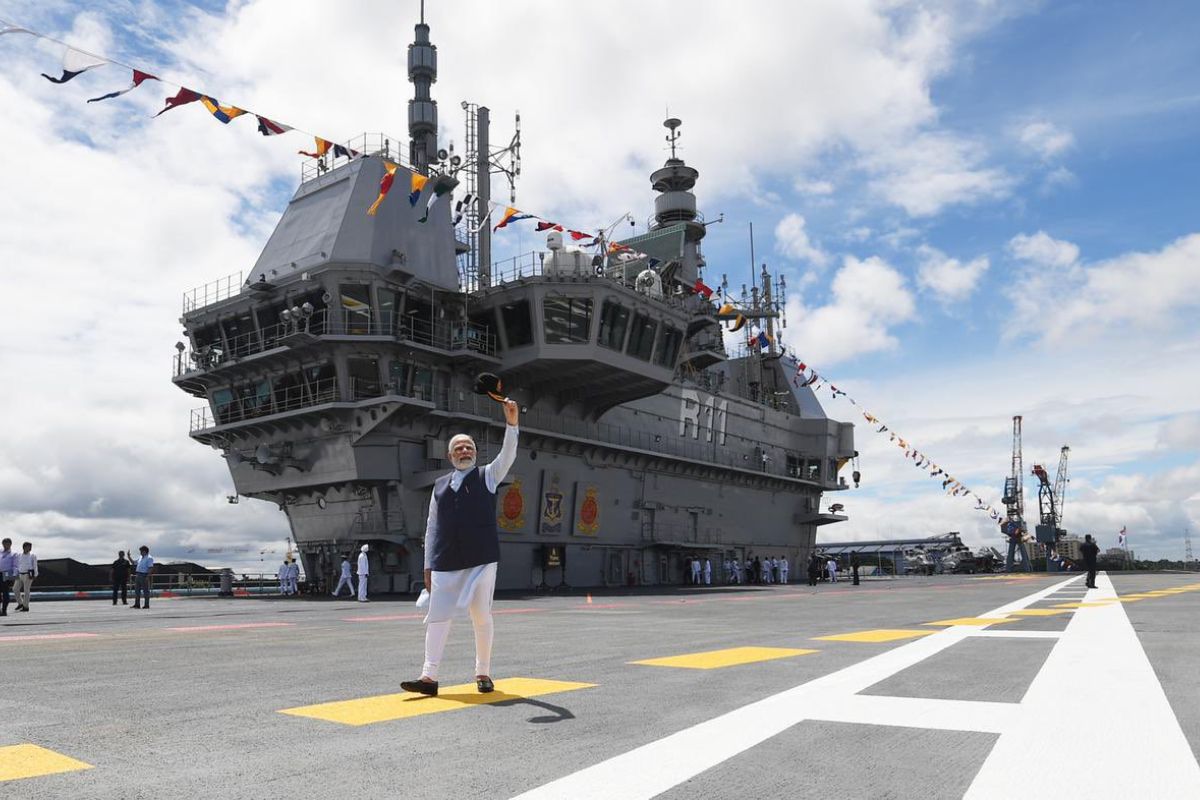Intel appoints Santhosh Viswanathan as India region head
Chip maker Intel on Friday said that it appointed Santhosh Viswanathan to head the India region business as its Managing Director (MD).
On Friday, Prime Minister Narendra Modi unveiled the new Naval Ensign ‘Nishaan’ at Cochin Shipyard Limited in Kochi, doing away with the colonial past and befitting the rich Indian maritime heritage.

PM unveils new Naval Ensign 'Nishaan', commissions INS Vikrant: 10 Facts
On Friday, Prime Minister Narendra Modi unveiled the new Naval Ensign ‘Nishaan’ at Cochin Shipyard Limited in Kochi, doing away with the colonial past and befitting the rich Indian maritime heritage.
During the commissioning of the indigenous aircraft carrier INS Vikrant, Prime Minister unveiled the new Naval Ensign ‘Nishaan’. Top 10 facts on INS Vikrant, 1st India-made aircraft carrier:
1. As a symbol of national pride, the erstwhile Indian Naval Ensign included the National Flag in the upper left canton, red vertical and horizontal stripes and a golden yellow State Emblem superimposed on the intersection of the red stripes. The national motto ‘Satyamev Jayate’ engraved in the Devanagari script, was included underneath the State Emblem. This White ensign has been flown by all formations, ships and establishments of the Indian Navy till September 1.
Advertisement
2. The White Ensign identified nationwide with the Navy, now comprises of two main constituents – the National Flag in the upper left canton, and a Navy Blue – Gold octagon at the centre of the fly side (away from the staff). The Octagon is with twin golden octagonal borders encompassing the golden National Emblem (Lion Capital of Ashoka – underscribed with ‘Satyamev Jayate’ in blue Devnagri script) resting atop an anchor; and superimposed on a shield. Below the shield, within the octagon, in a golden bordered ribbon, on a Navy Blue background, is inscribed the motto of the Indian Navy ‘Sam No Varunah’ in golden Devnagri script. The design encompassed within the octagon has been taken from the Indian Naval crest, wherein the fouled anchor, which is also associated with a colonial legacy, has been replaced with a clear anchor underscoring the steadfastness of the Indian Navy.
3. The Navy Blue colour of the above octagonal shape depicts the Blue Water capabilities of the Indian Navy. The twin octagonal borders draw their inspiration from Shivaji Maharaj Rajmudra or the Seal of Chhatrapati Shivaji Maharaj, one of the prominent Indian kings with a visionary maritime outlook, who built a credible Naval Fleet that earned grudging admiration from European Navies operating in the region at the time.
4. Naval Ensigns are flags that naval ships or formations bear to denote nationality. The current Indian Naval Ensign consists of a St. George’s Cross — a red cross with white background.
5. The Octagonal shape also represents the eight directions (four cardinal and four intercardinal), symbolising the Indian Navy’s global outreach. The Octagon stands for good fortune, eternity, and renewal and draws positive energy from all directions. The new Naval White Ensign is thus, rooted in the glorious maritime heritage of India, as well as reflective of our Navy’s present-day capabilities.
6. The President of India has approved the introduction of the new designs of the Naval Ensign, as also the Distinguishing Flags, Masthead Pennants and Car Flags for the Indian Navy. Formations, ships and establishments of the Indian Navy would be adopting the new Naval ensign, as also the new distinguishing flags, car flags and masthead pennants.
7. PM Modi said, “INS Vikrant is a floating airfield, a floating town.”
8. INS Vikrant is 262 metres long and 62 metres wide. It is the largest warship built in India. The warship can accommodate a crew of nearly 1,600. IAC Vikrant consist of 14 decks with 2,300 compartments which can carry around 1,500 sea warriors to cater to the food requirements, around 10,000 chapatis or rotis are made in the ship’s kitchen, which is called the ship’s galley.
9. INS Vikrant is named after its predecessor, which played a key role during the 1971 war against Pakistan for the liberation of Bangladesh.
10. The ship would be capable of operating an air wing consisting of 30 aircraft comprising of MIG-29K fighter jets, Kamov-31, MH-60R multi-role helicopters, in addition to indigenously manufactured Advanced Light Helicopters (ALH) and Light Combat Aircraft (LCA) (Navy). Using a novel aircraft-operation mode known as STOBAR (Short Take-Off but Arrested Landing), the IAC is equipped with a ski- jump for launching aircraft, and a set of ‘arrester wires’ for their recovery onboard.
Advertisement